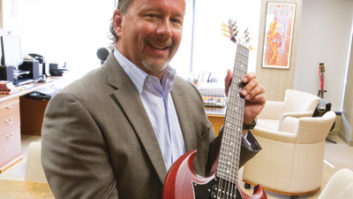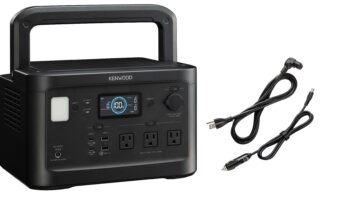In an era of continuing dealer consolidation, the retail tail is increasingly wagging the dog within the consumer electronics and major appliance industries.
Indeed, in CE alone, the combined 1998 revenues of just four merchants — Best Buy, Circuit City, RadioShack and Sears – represented better than one-third of total category sales.
Given that concentration of category clout, TWICE decided to take a closer look at the marketing plans, sales strategies, product mix and financial doings of these four power retailers as they hit the midyear point and gird themselves for battle in the coming century.
Best Buy
What a difference three and a half years can make.
Back in Christmas 1995, the electronics superstore got stuck with $375 million in outdated PCs after the industry had moved on to the next-generation microprocessor. It was a costly mistake that CEO Dick Schulze would never make again.
Since that time, the top-ranked retailer on the TWICE CE Retail Registry has tightened the reins on inventory management, improved its distribution and logistical systems, and learned to love point-of-sale data. By fiscal 1998, the operation was virtually debt-free, and Best Buy has now become a retail darling of the investor crowd.
Not one to sit on his laurels, Schulze forged a next-chapter strategy designed to carry the $10 billion company well into the 21st century. Seizing upon the coming digital revolution in all things electronic, Best Buy became a vocal advocate of binary-based products and has set about revamping its 314 stores to better showcase the category.
Indeed, its 45,000-square-foot Concept 4 design, with its cleaner, more open selling floor and logical product adjacencies, has been designated to lead the company toward its digital destiny. Plans call for the addition of some 50 new Concept 4 stores a year through 2004, as well as the rollout of new smaller format units for mid-sized markets with populations between 100,000 and 200,000. All told, the effort should bring Best Buy’s store count to about 550 in five years, giving it blanket coverage of the continental U.S.
At the same time, the company has been gearing up for a full-assortment Internet presence by bringing in Peapod.com COO John Walden to head up the effort and developing a new e-business platform for expanded sales and SKUs.
“Best Buy has found an incredible formula of price, selection and outstanding marketing,” observed George Sutton, managing director of market analysts Dain, Rauscher and Wessels in Minneapolis, Minn. “They’ve convinced consumers that they will get very low prices with minimum sales pressure, and their focus on digital technology has created the idea box in consumers’ minds that they need these new products.”
“Best Buy operates a very well designed and effectively merchandised consumer electronics superstore,” added Amy Wright, a channels analyst with market research firm ARS in La Jolla, Calif. “They use aggressive pricing and heavy advertising to aid in sales, and use items like music CDs as loss leaders to increase consumer volume and earn a reputation as a low-price retailer.”
Apparently, the formula is working. The retailer’s fiscal first-quarter earnings for the three months ended May 29 tripled to $47.3 million on revenues of $2.39 billion, an increase of 13.3% in same-store sales.
Circuit City
Having put its failed experiment with the Divx DVD format be-hind it (along with a $114 million post-tax charge), and finally realizing a quarterly profit from its parent’s 75% stake in CarMax, Circuit City can now turn its undivided attention to its core CE, PC and appliance businesses. Those operations are humming along nicely for the nation’s number two CE retailer.
Minus the Divx termination charge and a $16 million operating loss for the venture, the company’s retail stores enjoyed a 65% hike in earnings from continuing operations to nearly $40 million for the three months ended May 31, while same-store sales rose 9% to $2.2 billion.
Some of the groundwork for the store’s earnings success was laid in fiscal 1999 (which ended in February), when the category killer ramped up a number of in-store and back-end efforts. Among the former: computer build-to-order stations, introduced last summer, that allow consumers to virtually design their own PCs by using a touchscreen to select from a broad range of features offered by IBM, NEC, Hewlett Packard and Compaq.
On the operational front, Circuit City continued to edit its assortment by reducing the number of products with similar features and prices, and it has pushed vendors to develop shorter inventory pipelines to reduce the time between a product’s manufacture and retail sale. According to president Alan McCollough, these steps, instituted over the past three years, have helped limit gross margin erosion from aging inventory.
Product-wise, Circuit claims sales leadership in camcorders, DirecTv satellite systems and, at least last Christmas, DVD players, while the store is pioneering the introduction of cable modems into the retail marketplace through a cooperative effort with MediaOne.
On the store front, about 30 units were remodeled last year to accommodate a wider assortment of such home office products as computer software, peripherals, upgrades and accessories. Another 50 superstores are expected to be similarly revamped by February, while Circuit continued its aggressive expansion plan by opening nine new units during the just-ended quarter, bringing the total to 594 retail stores.
At the same time, the store is about to begin selling products directly from its web site. A new E-Superstore section, set to bow this month, will initially offer about 700 name-brand audio, video, computer, telephone and floor care products, and will eventually encompass refrigerators, washer/dryers and satellite TV systems.
“Circuit City’s intent is to provide a site that is fully integrated with the operations of its brick-and-mortar business,” said ARS’s Wright. “Consumers will be able to order products online and pick them up at, or return them to, a Circuit City store. This is a unique strategy that is particularly conducive to the sale of larger consumer electronics products. Although the strategy brings about unique logistical complications, if done properly the differentiation could lead to happy and loyal online customers.”
RadioShack
The revolution already fomented at Tandy under CEO Len Roberts’ leadership continues to transform the nation’s number four CE retailer from a sleepy source for spare electronics parts to a leader in wireless phone and DirecTv sales.
Through his recently forged “strategic alliance” with Thomson, Roberts hopes to extend that dominance to audio and video via the RCA name, while further distancing the store from its association with the private-label Optimus brand.
The five-year deal with Thomson continues an in-store shop concept that was launched three years ago with the installation of The Sprint Store and was extended to the PC sector with Compaq Creative Learning Centers. Beginning next spring, some 4,000 company-owned RadioShacks are expected to feature 18- to 24-foot RCA digital Entertainment Centers, with additional stores to be retrofitted throughout the balance of 2000. With this strategy, Roberts in effect traded category exclusivity and the chain’s unmatched 7,000-unit national penetration for a long-overdue refurbishing of his stores at the suppliers’ expense.
Moreover, as Roberts conceded, the partnership with Thomson represents another piece of a home connectivity strategy that includes high-speed Internet access (through Sprint and Northpoint Communications) and, eventually, cable television and in-home installation services.
Meanwhile, as it continues to add new storefronts to the roster, RadioShack is busily preparing to enter the realm of cyber sales, having announced a fall launch date for a 30,000-SKU Internet “supersite” called radioshack.com.
With its failed Incredible Universe and Computer City experiments behind it, and the new initiative kicking in, Tandy was able to realize a 51% hike in net income for the first quarter of this year to $56 million, while June sales rose 17% to $291 million.
Sears
After playing the role of comeback kid for the better part of the decade, Sears has hit a snag.
Chairman Arthur C. Martinez was widely lauded as the store’s savior when, shortly after joining the company from Saks Fifth Avenue in 1992, he launched an aggressive program of cost-cutting, store renovation, assortment overhauls and marketing that quickly returned the retail business to profitability.
But as the century comes to a close, an over-reliance on its private-label credit card business has begun to take a toll on the top and bottom lines, and the once snappy “Softer Side…” campaign has lost its steam. At the same time, a reinvigorated department store channel and an upwardly mobile mass merchant tier have effectively outflanked Sears and its sister national chains Montgomery Ward and JCPenney, which are steadily losing their customer base.
The result: Sears continues to trail its retail peers with a paltry 1% uptick in 1998 sales and an anemic 1.9% rise in same-store revenue this June despite one of the strongest boom markets for merchants in recent memory.
Yet if Sears’ soft-goods business is withering, its consumer electronics and appliance war machine continues unabated. In CE, the store maintains its status as the nation’s fifth largest electronics merchant, boosting category sales 9.5% last year to $3.5 billion, while it remains the 500 pound gorilla in white goods with 1998 sales of $5.1 billion, a 7.4% increase over the prior year.
To put its majap mojo in perspective, the next closest competitor in the sector, Circuit City, posted category sales of $1.4 billion last year according to the TWICE 1999 Major Appliance Retail Registry.
Moreover, Sears’ appliance business appears poised to enter hyperspace now that its white goods are available over the Internet. Indeed, beginning in May, www.sears.com began offering some 2,000 brand-name products online, with delivery promised in less than a week for a fee of $35.
So where does the venerable retailer go from here? In June, Martinez told Wall Street analysts that “we continue to build market share in key appliance and home electronics categories,” and that a major new advertising campaign will be introduced this fall.
According to ARS’s Wright, Sears does appear to be on track to create a stronger organization and a more up-to-date image, and said, “Although it is unfortunate that the company did not attack these issues before it experienced lackluster results, it is visibly working to fix them. As long as Sears continues to focus on its target audience, training its salespeople and periodically reassessing its product mix, it should continue to be relatively successful within its target market.”









